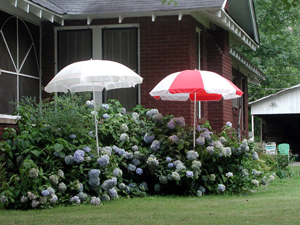Resource Library
Plant of the Week: Shade and Sun in the Garden
The University of Arkansas System Division of Agriculture does not promote, support or recommend plants featured in "Plant of the Week." Please consult your local Extension office for plants suitable for your region.
Plant of the Week
Shade and sun in the garden

On the surface, gardening seems to be such a simple hobby, but any who indulge themselves in this battle of wits against the rapaciousness of the natural world knows otherwise.
Good gardeners recognize growing plants is not a recipe to be followed so much as series of nuanced judgment calls that must be interpreted like some oracle reading tea leaves in the bottom of a cup. Assessing the quality and quantity of light available in the garden is one of the subtleties gardeners must evaluate when selecting plants to grow and finding the perfect spot for them in the garden.
Plant care tags and many how-to books, usually by means of some arcane form of hieroglyphic iconography, tell us that plants thrive best in full sun, part shade or full shade. While this is a helpful starting point, it doesn’t tell much about the nature or quality of the sunlight available to drive the process of photosynthesis.
Light energy from the sun travels both as a particle and a wave. The discrete packet of energy, called a photon, is one of the subatomic particles physicists like to describe to we mere mortals in incomprehensible mathematical terms. To simplify things in my own mind, I like to think about photons as various colored jelly beans. Some will be red, some yellow, some blue and represent the various wave lengths by which the photons travel. It is these photons (the jelly beans) that drive the photosynthetic machinery inside the plant cells.
In full sun situations the jelly beans are uniformly dispersed across the surface of the garden and most plants actually get more sunlight than they can use. Bermudagrass is a fine example of a plant that requires full sunlight to grow and I use it as an indicator plant for full sun conditions. While it might get by with as little as six to eight hours of direct sun, any less will result in the plant stopping growth and quickly fading away. If the garden is on a south or west facing slope the jellybeans impact the garden at an acute angle and in addition to lots of light, the heat begins to build up thanks to all those red jellybeans. If there is a north- or east-facing slope to the garden the jelly beans strike the surface at a less acute angle and, while there is still plenty of light energy, less heat builds up.
In a part shade environment some of the jelly beans stick to the leaves of trees or the roofs of buildings so fewer make it to the leaves of the plants closer to the ground. The obstructed light may be caused by a building where the plants get morning sun and afternoon shade or by a high canopy of tree leaves where a dappled light pattern exists throughout the day. What matters to the plant is not the particulars of how the shade is caused, but the number and kind of jelly beans reaching the leaves. If the shade is caused by the building, the mix of various colored jelly beans will be approximately the same as full sun situations.
I use grass growth as an indicator of part shade conditions. In these partly sunny sites, bermudagrass will not grow but other grasses – especially the cool season grasses such as fescue – will continue to grow if not exactly thrive. Flowering shrubs such as spirea, forsythia or even roses will flower, but not as profusely as if located in full sun conditions. Hydrangeas and azaleas flower best in bright but cool conditions so partial shade is an ideal location for these garden stalwarts.
Full shade conditions are those sites where there is too little light for any kind of grass to grow. While this seems straightforward, sometimes grass won’t grow because the tree roots keep the soil too dry for it to succeed. In a full shade environment more red jelly beans are stuck to the tree leaves, allowing more of the blue jelly beans at the cooler end of the visible spectrum to pass through to the plants below. The reason it is cooler beneath shade trees in the summer is, in part, because fewer of the high-energy red jelly beans make it to the ground.
Perhaps only 20 percent of the plants we grow in our gardens tolerate full shade but that still leaves plenty from which to choose. Hardy ferns, hostas, a host of woodland wildflowers, and a wide array of shrubs can grow in these lower light conditions.
By: Gerald Klingaman, retired
Retired Extension Horticulturist - Ornamentals
Extension News - April 20, 2012
The University of Arkansas System Division of Agriculture does not maintain lists of retail outlets where these plants can be purchased. Please check your local nursery or other retail outlets to ask about the availability of these plants for your growing area.